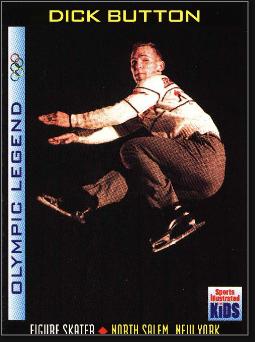
Dick Button
Sport: U.S. Olympic Figure Skating
Born: July 18, 1929
Town: Englewood, New Jersey
Richard Totten Button was born July 18, 1929, in Englewood. Dick was a talented skater but did not concentrate his full efforts on the sport until he began training in New York with Joe Carroll, around the age of 12. On Carroll’s advice, Dick’s father hired another coach, Gustave Lussi, who trained students year-round at Lake Placid. Lussi was especially good at teaching spins; he originated the fundamental jumping techniques most pro skaters use today.
The move paid off quickly, as Dick became a regional and national junior champion in 1944. In 1945, he captured the Eastern States Seniors title (against adult competitors) as well as another national junior title. In 1946, Dick won the U.S. Championships at the age of 16. That same year, he and Barbara Jones won the Eastern States junior pairs championship.
Dick became an international sensation at the 1948 Winter Olympics in Switzerland. While practicing for the free skate portion of the competition, he landed a double axel for the first time. The next day he landed it during competition—the first skater ever to do so. The jump starts with a forward-facing takeoff, includes two and a half rotations, and finishes with the skater facing backwards.Dick received perfect 6's from several judges—a first for an Olympic figure skater.
Dick won the Olympic gold medal and went on to win gold at the World Championships and US Championships in 1948. In 1949, he won the Sullivan Award as America’s top amateur athlete. Dick enrolled at Harvard and skated competitively until he graduated in 1952. During this time, he won four more World Championships and unveiled a new groundbreaking sequence each season. He is also credited with the invention of the Flying Camel spin, being the first male skater to perform it.
At the 1952 Winter Olympics in Oslo, Dick had a big lead after the figures portion of the program. In the free skate, he stunned the crowd with a triple loop. It marked the first time a skater had landed any kind of triple jump in competition. Dick later admitted he could have won gold without the triple loop—and might have lost it had he crashed—but said he would have gone through the rest of his life with "an emptiness" had he not pushed the envelope on the sport's greatest stage. Ever the perfectionist, he felt the gold-medal performance was only 99 percent his best; he'd been at 100 a few days before the competition.In all, he won five world championships and seven U.S. championships to go along with his Olympic medals.
After winning his second gold medal, Dick enrolled in law school. The workload would not allow him to train the way he needed to, so he retired from amateur skating. Dick continued to skate as a professional, joining the Ice Capades during law school breaks. After earning his degree, he continued to skate in ice shows, and also parlayed his fame and showmanship into a series of stage and screen roles.
In 1960, he joined the CBS broadcast team at the Winter Olympics. It marked the beginning of a 50-year career as a skating commentator—mostly for ABC—during which his journalistic standards and no-holds-barred analysis helped to popularize skating as a mainstream spectator sport. When the World Figure Skating Hall of Fame opened in 1976, Dick was among its first group of enshrinees.
|